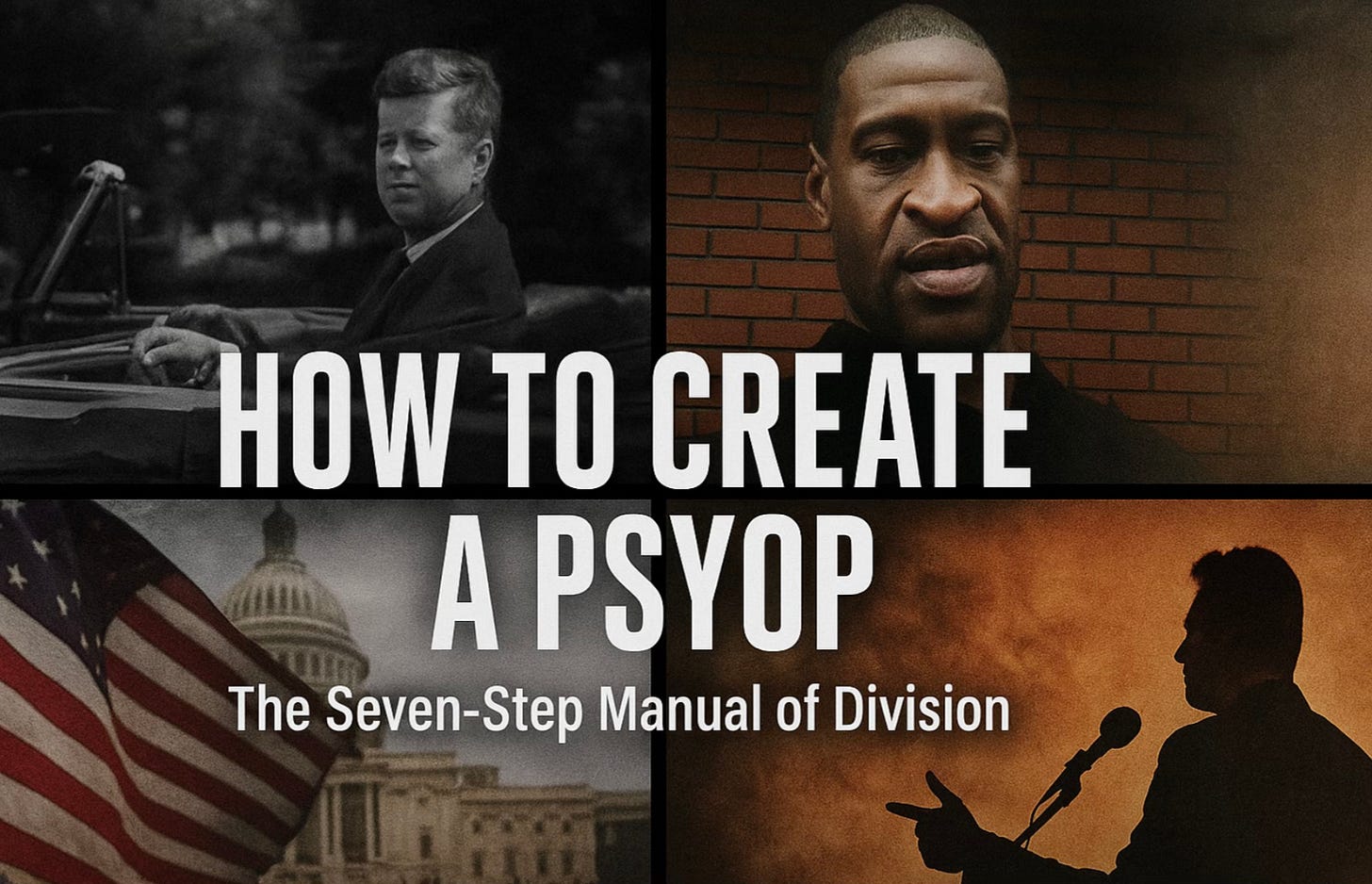How to Create a Psyop
The seven-step manual for how events become weapons — and how the public runs the operation for free.
Every major political shock in recent memory has followed the same script. A trigger event happens, and within hours the country is no longer debating facts, but tearing itself apart along preloaded tribal lines.
It happened this week. It happened last decade. It happened sixty years ago.
This isn’t coincidence. It’s psychological warfare. And whether designed or organic, it works the same way every time.
Here’s the playbook.
Step 1: Find Your Trigger
The first rule is shock. You need an event sharp enough to pierce reason and ignite reflex.
An assassination.
A riot.
A scandal.
It doesn’t have to be consistent. In fact, the murkier, the better. The less people understand, the faster they fill in the blanks with fear, suspicion, and fury.
Confusion isn’t a by-product. It’s the raw material.
Case Study: Dallas, 1963
President Kennedy is shot. Within minutes there are multiple suspects, conflicting accounts, endless contradictions. Sixty years later, the fog has not cleared. Confusion itself became the legacy.
Step 2: Preload the Scripts
Outrage doesn’t write itself. You preload the lines long before the trigger lands.
The formula is simple. Keep the slogans short. Keep them emotional. Keep them binary.
“The Left wants murder.”
“The Right breeds hate.”
They’re not arguments. They’re reflexes. They bypass thought. They demand no evidence, only anger.
The moment the trigger hits, the lines erupt like muscle memory. The crowd thinks it’s speaking from the heart. In reality, it’s repeating lines that were waiting in its bloodstream.
Case Study: Cold War Active Measures
1970s Soviet operations seeded Western media with slogans: “America is racist. America is violent. America is collapsing.” Not reasoned arguments. Templates designed to divide.
Step 3: Flood the Zone
Truth is irrelevant. Volume is everything.
Once the trigger lands, you bury the public in noise. Fake celebrity quotes. Fabricated tributes. Screenshots of headlines. AI-generated recaps. Contradictory stories about suspects. Viral footage from who-knows-where.
It doesn’t matter if any of it’s real. What matters is that it’s shareable.
The effect is not clarity but overload. Nobody can separate fact from fiction. Nobody can keep up. People stop trying to think. They just react.
The flood doesn’t expose the truth. It drowns it.
Case Study: Ferguson, 2014
Dozens of videos. Conflicting angles. Competing hashtags. Narratives take shape before investigations finish. Truth becomes secondary to the flood of content.
Step 4: Polarize the Herd
Now you divide.
You compel people to pick sides. Left or Right. For or against. With us or with them.
The categories don’t need substance. They only need loyalty.
So the death of one man becomes proof of an entire worldview. Ordinary citizens rush to declare allegiance. They change their profile pictures. They post their slogans. They denounce the enemy tribe.
What could have been grief becomes tribal warfare. What could have been reflection becomes reflex. That’s the binary at work.
Case Study: January 6, 2021
One crowd waves the flag of freedom. Another crowd sees only insurrection. The same footage fuels two realities. Both sides convinced only theirs is true.
Step 5: Harness Mass Formation
Once the binary is lit, the mob carries the operation for you.
Individuals dissolve into the crowd. They bond through outrage. They validate each other’s rage. They lose the ability to think for themselves.
Scroll the feeds and you’ll see it: the same lines repeated by thousands of accounts. Some automated. Some human. All indistinguishable.
This is mass formation. The psyop no longer needs handlers. The crowd has become the machine.
Case Study: George Floyd, Summer 2020
Crowds chanting in unison, repeating slogans written by committees. Individual thought collapses into the comfort of the collective voice.
Step 6: Displace and Project
A shock event always raises dangerous questions. Was it professional? Who benefits? Was it foreign or domestic?
These are the questions that can break the illusion. They must be smothered.
So you redirect the energy. One tribe blames the other for murder. The other tribe blames back for extremism. Each side projects evil outward. Each side feels righteous. Neither side asks the forbidden question.
The displacement is perfect. Fear and confusion don’t vanish. They’re weaponized.
Case Study: September 2001
The towers fall. Instead of asking who armed and financed the hijackers, the public is guided into a binary: freedom versus terror. To question is disloyalty. The projection works. The wars begin.
Step 7: Stay Invisible
The final rule is silence. The architects never appear.
By the time the mob is screaming, the job is done. Nobody asks who seeded the fake posts. Nobody wonders why the shooter’s profile changed three times in three hours. Nobody notices how the slogans snapped into place before the facts were known.
The public spends its energy hating each other. The real beneficiaries remain untouched.
Case Study: Lisbon, 1960s
Aginter Press, a clandestine mercenary network, trains operatives in the art of “false flag” terror and narrative manipulation. Their golden rule: stay invisible. Let the enemy factions destroy themselves.
The Template
This is how it works.
A trigger.
Preloaded scripts.
A flood of noise.
Forced polarization.
Mass formation.
Displacement.
Invisibility.
That’s how you create a psyop.
Not with bullets, but with reflex.
Not with evidence, but with slogans.
Not with generals, but with citizens who mistake their rage for resistance.
The Reader’s Test
If you think you’re resisting, ask yourself whether you’re just repeating the lines.
If you think you’re declaring truth, ask whether you’re simply proving the psyop works.
That’s the real measure. Not whether you chose the right side. But whether you chose at all.



